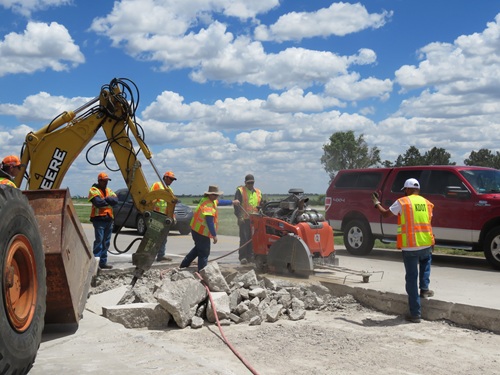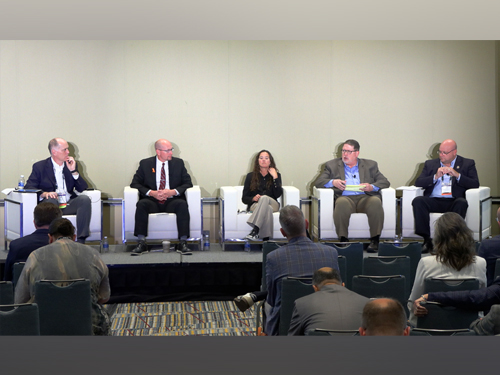A knowledge session at the American Association of State Highway and Transportation Officials 2025 Spring Meeting in Hartford, CT, examined some of the potential risks and rewards of alternative project delivery methods, such as design-build processes.
[Above photo by AASHTO]
Moderated by Jay Chiglo, transportation alternative delivery director for engineering firm HDR, the session featured Calvin Reed, secretary of the Kansas Department of Transportation; Carmen Swanwick, project development director for the Utah Department of Transportation; George Conner, deputy director of operation for the Alabama Department of Transportation; and Will Watts, assistant secretary for engineering and operations at the Florida Department of Transportation.

“Alternative project delivery” is typically defined as using custom methods developed collaboratively between a state department of transportation and its contractors; methods that seek to streamline design and construction processes and timelines; reduce risks; and provide opportunities for innovation. Examples of alternative delivery methods include Design-Build, in which one entity – the design-build team – works under a single contract with a state DOT to provide design and construction services; Construction Manager at Risk, where the owner hires a construction manager to oversee the project from design to construction close-out and deliver it with a guaranteed maximum price provided to the owner prior to the bid stage; Construction Management Multi-Prime, where the project owner contracts directly with multiple prime contractors instead of a single general contractor, with each prime contractor handling a specific scope of work; Public-Private Partnership, where a public sector entity joins with private sector firms for the purpose of delivering a project or a service traditionally provided by the public sector; and Integrated Project Delivery, where key parties involved in the design, fabrication, and construction aspects of a project are joined together under a single agreement.
The panelists offered a wide range of experiences with such alternative delivery methods. Florida DOT’s Watts noted his agency started “experimenting” with them in 1987 “out of necessity due to the sheer volume of work we faced” and then “getting into high gear” with them starting in 2000. Meanwhile, Alabama DOT’s Conner said his state “is brand new to this, but we jumped in with both feet” due to the promise of better “risk assessment and allocation” analysis as his agency tackles complex and expensive transportation projects.

Kansas DOT’s Reed noted that, like Alabama, his state has been “a little bit of a late adopter” of alternative delivery methods. In fact, the state legislature authorized the agency to use alternative delivery on only one project between 2010 and 2020 – which turned out to be a $240 million interchange project outside of Kansas City, MO, which sits on the Missouri River right over the border from Kansas.
Reed said his agency used design-build to construct that interchange “largely to speed up both the construction and delivery of the project, but also as a proof of concept.” And part of that “concept proving” process included getting the construction contracting community on board with Kansas DOT’s alternative delivery plan.
“If they are not familiar with alternative delivery – and a lot of contractors in Kansas are not – they’re going to be skeptical of how to do [projects] differently. Yet we, as a transportation industry, kind of get stuck in a rut sometimes and we don’t think there’s a better way to build a mousetrap,” he explained. “That’s why I think alternative delivery, in its many forms, does present that potential. Because every project is unique in some way and requires unique tools. This was a unique project for us that we were able to use this unique tool. Now, it’s a matter of us honing that tool, making sure we’re able to continue to deliver on projects like this in the future.”
Yet Utah DOT’s Swanick said alternative delivery options are in some way getting more challenging to use due to higher concerns about risk allocation.
“We’ve seen that some contractors are getting less and less interested in design-build projects, because as owners, we’ve been pushing a lot of risk onto the contractor,” she said. As a result, “at least in Utah, we’ve been trying to reevaluate those risks and take some of those risks back.”

But those risk re-allocation discussions are not leading Utah DOT to pull back from alternative delivery, Swanick stressed. “A lot of times we’re moving into alternative delivery because we need to get something done and we need to get it done fast,” she said. “But now we are making more sure that we are reasonable and fair. In the end, it is all about the ability to make timely decisions. Time is money, especially on an alternative delivery project. These projects move fast, and you need somebody that’s responsible, that can take that ownership and make those decisions.”
Risk assessments proved key to properly deploying alternative methods, Alabama DOT’s Conner said. “Understanding that risk allocation – the proper balance when it is appropriate for the owner to retain or even assume a different risk profile than they may be used to, and when it is not – it has been a growth experience for our agency,” he explained.
“And then, as they are all with big projects and with alternative delivery, you have to make sure the financing is solid as it relates to our construction contractors and our stakeholders,” Conner noted. “We need to ensure that the [alternative delivery] work that we’re doing is not only properly financed, but ensure that financing, that plan that we put in place, does not lessen what we need for our everyday [transportation] program.”
Florida DOT’s Watts noted that his agency had to retool its design-build contracting strategies during the COVID-19 pandemic as project risks – especially in terms of rising costs – became untenable in many ways. So Florida DOT revised its efforts to focus on more collaboration with the contracting community that by extension helps encourage more project innovation – innovations that ultimately lower costs and further speeds up project delivery timelines.
“That is why this idea of working together with the contractor and understanding risk – and allocating that risk properly during the [design-build] process – is so important,” he said. “You’ve got to create an environment where they want to tell you what that risk is. We don’t suggest what that risk is; we let them form that [risk assessment], then send it back to us so we can digest it and understand it. It’s about creating an environment where everyone is as transparent as possible. They’re showing you what they think they’ll run up against; the unknowns of a project. And then you have some play on what those unknowns are and how you can minimize them.”
 Nation
Nation
The State DOT Role in Safer Land Use Decisions
October 31, 2025 Nation
Nation

